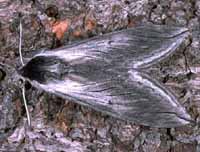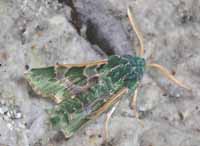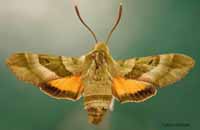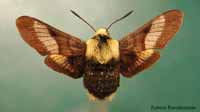Sphinginae subfamily
Sphingini tribe:
 |
This species is probably present (unreported) and larvae feed on tomatoes and go by the common name of
"Tomato Hornworms". |
 |
Although not reported from Lincoln, I suspect it is present.
I only see them occasionally on P.E.I. despite visiting lights frequently. |
 | The upperside of the forewing is dark grey to black with a
paler costa and pale area from the base to the wing's centre.
Prefered habitats include montane woodlands and mixed chaparral-type
vegetation. |
 |
Sphinx vashti
USGS, the Snowberry Sphinx
The upperside of the forewing has a narrow black subterminal line
bordered by a white inverted V-shaped line on the outside, and a
black line running inwards from the apex of the wing.
It is most often found in montane woodlands and along streamcourses. |
Smerinthini Tribe:
 |
Pachysphinx modesta WO,
the Modest Sphinx or Poplar Sphinx,
This large poplar/willow feeder is probably quite common in Lincoln.
They are a heavy bodied species.
|
 |
This one is quite similar to Pachysphinx modesta, with modesta being smaller and darker.
There may be naturally occuring hybrids in Lincoln.
|
 |
The grey-blue eyespot of the hindwing gives this species its name.
Larvae feed on birches, willows, cherries and oaks.
The outer edge of the forewings is quite scalloped. |
 |
This small species is probably widespread and common. This species ranges across North America.
The hindwings have a small blue eyespot ringed with black on a yellow background.
|
 |
If you have willows and poplars nearby, you've probably got populations of
the Cerisyi's Sphinx. The hindwings are quite striking. |
Macroglossinae subfamily
Dilophonotini tribe
 |
Hemaris diffinis WO, the Snowberry Clearwing or Bumblebee Moth
Although not officially reported from Lincoln, this day flying moth
is widely distributed in Washington.
I suspect I will get reports from Lincoln County. |
Macroglossini tribe
 |
Arctonotus lucidus PE, the Pacific Green
Sphinx Moth or Bear Sphinx Found to the north, east and west, this species
is probably present.
It tends to be an early spring flier, on the wing in the early
evening. It comes to lights at night. |
 |
Hyles gallii WO,
the Bedstraw Hawk Moth or Gallium Sphinx
This species is not officially reported from Lincoln County, but if
you have Gallium or Epilobium, you probably have
populations of this species. |
 |
Hyles lineata WO, the White-lined Sphinx
This species is very widespread. It can be seen flying during the day,
into the evening and also at night.
The highly variable larvae are often found in people's gardens. |
 |
Although not officially reported from Lincoln County, this day flier,
April-June, prefering oak woodland and pine-oak woodland in foothills,
is probably present. Moths nectar at a variety of flowers in the afternoon.
|
 |
This day flier is not officially reported from Lincoln, but it has been
found to the north, east south and west in meadows near coniferous forests. |
|
|